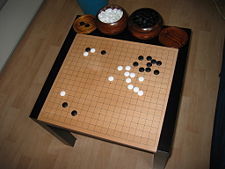Go (board game)
Go is a board game played by two players. It is also referred to as Weiqi in Chinese (圍棋; 围棋), Baduk in Korea (바둑) and Igo or Go in Japanese (囲碁; 碁). Go is the worlds oldest game that is played in its original form, with a documented history of over 2.500 years.
Character
Go is played on a flat board with a grid of 19x19 intersections. Two sets of white and black stones are used. The game is played in turns and unlike Chess, black makes the first move in go. Each stone is placed on an intersection and the goal is to capture more territory than the opponent. Go is one of the most complex games in the world, far outweighing games such as chess in the number of possible game positions. In go, it often matters whether a given move is beautiful or produces good shape.
History
There is no exact date for the invention of Go. One legend dates the invention to the Emperor Yuo who taught the game to his eldest son Dan Zhu. Most modern writers think, that this legend (and a few similar legends), were written down in the Han period, to make the game appear older than it really is. They date the invention to 1000-400 BC.[1]
Comparison to chess
Compared to chess go recquires more activation in the right parietal brain areas.[2]
Go is conceptually simpler than chess (especially when go rules are properly formulated):
- A go player has only one kind of pieces, called stones. A chess player has six kinds of pieces (king, queen, rook, bishop, knight, pawn, and one of her/his bishops runs on white squares, while the other one on the black--thus they are actually different too).
- A go player makes only one kind of moves, namely setting a stone on an intersection point (the effect may be different each time, causing sometimes a group of opponent stones to be removed). A chess pawn has four kind of moves: 1.going one step forward, 2.going two steps forward from its initial position, 3.capturing an opponent's piece one step askew from it and landing where the opponent's piece was, 4. capturing opponent's pawn en passant. On the top of it, the pawn, which reaches the last row gets promoted.
- Go has essentially only one (very natural) restriction on moves: a move which would lead to a repetition of position is illegal (not allowed). It has also another rule, which disallows a suicide, but it's only a cultural move, not essential to the game. In chess too we have a cultural rule which disallows to put your own king in check. In addition, we have also several essential rules which contribute to the total chess rules complexity: castling, en passant, promotion and the rules about draw by repetition or by making 50 moves by both sides without any capturing and without any pawn move.
Chess as a whole does not admit any natural, regular generalizations onto larger boards (but many chess endings do). In the case of go, one may play the game on the square boards of arbitrary n by n size, and also on rectangular m by n boards. More than that, one may play go on arbitrary finite simple graphs. Thus go is so mathematical that it provides a graph invariant: with arbitrary graph we may associate the result of the game played optimally by both players (mathematical theory of games states that such optimal strategies exist; it's a corollary to the respective Zermelo's theorem, 1913).
Major Titles
There are 7 major go titles in Japan. The record for winning the most titles over the years is held by Japanese professional Cho Chikun, who has won 71 titles.
| Tournament | Prize money | Current title holder |
|---|---|---|
| Judan | Cho Chikun | |
| Tengen | Kono Rin | |
| Oza | Yamashita Keigo | |
| Meijin | Takao Shinji | |
| Gosei | Cho U | |
| Honinbo | Takao Shinji | |
| Kisei | Yamashita Keigo |
Cultural Dimensions
Go strategy is also studied as an metaphor for Asian strategy compared to western strategy.[3]
See also
External Links
Go Associations
- European Go Associantion
- Nihon Kin - Japanese Go Association
- International Go Association
- American Go Association
- Korean Go Association
